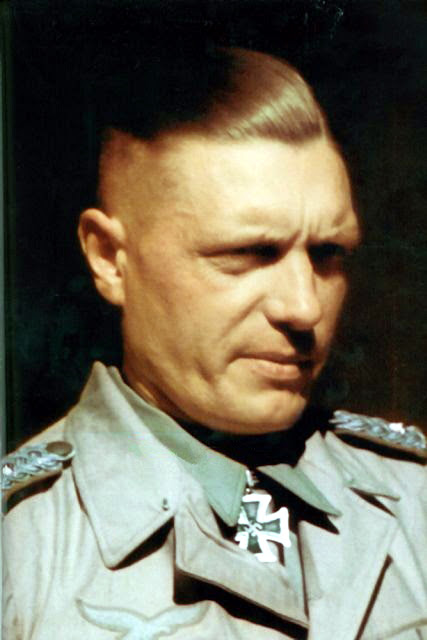Karl-Lothar Schulz (30 April 1907 – 26 September 1972) joined the Army on leaving school and briefly served with an Artillery regiment, though his own personal training was as a pioneer. He joined the Police in 1925 and in 1933 was transferred to the newly formed Polizei Abteilung z.b.V. Wecke, the forerunner of the elite Hermann Göring Division. He was commissioned as a Police Lieutenant in 1934 and remained with the unit as it evolved into Landespolizeigruppe General Göring. In September 1935 the unit was transferred into the Luftwaffe as Regiment General Göring. Göring decided that amongst his new elite troops would be a body of men trained as paratroopers. A call for volunteers went out, and Schulz was one of the first to come forward. He subsequently underwent paratrooper training and served as company commander of 15 (Pionier) Kompanie, a component of the parachute-trained IV.Bataillon / Regiment General Göring. By 1940 Schulz had been promoted from company commander and was serving as commander of III.Bataillon / Fallschirmjäger-Regiment 1.
During the campaign in the West, Schulz and his men dropped into Holland to seize the airport at Waalhaven near Rotterdam, in order to allow the rapid landing of more German air-landing troops. The airport was defended by a battalion of Dutch troops supported by an AA battery of 7.5 cm guns, two light armoured vehicles (Vickers universal carriers) and a platoon of 2 cm anti-aircraft guns. The Dutch defenders opened fire on the German paratroops as they descended but the Fallschirmjäger suffered only relatively light casualties. Shortly after the paratroopers had landed, elements of two companies of Infanterie-Regiment 16 / 22.(Luftlande)Infanterie-Division arrived on the scene to give support, and with their help the Schulz-led paratroops secured the airfield. Schulz was able to send out a message giving the all clear for German aircraft to begin landing elements of 22.(LL)ID. The RAF attacked with six light bombers the German positions, before being driven off by the Luftwaffe with all but one of them shot down. A further Dutch counter-attack during the first war-night was repelled before it even started. A large scale RAF night raid - involving six Vickers Wellington medium bomber squadrons - caused quite some damage on landed German material, but hardly paid out operational gains.
On the second day of the invasion Schulz and his Third Battalion were transferred to the Dordrecht areas, where another set of bridges was held by German airbornes. Schulz and his unit got tied up in a series of battles and skirmishes with Dutch elements countering the German bridgehead. On the third day of the invasion the 9. Panzer-Division crossed the bridges at Moerdijk linking up with the airborne regiment holding these crossings. From then on the airbornes were more or less released of their duties, although few would still see some more action in the consecutive fights remaining during the last two days before the Dutch capitulation.
During his command of III./FJR 1 in the Netherlands campaign Schulz was accused by the Dutch of several cases of infringements of the international law. On the first day he was accused of abusing POW's at Waalhaven AFB and on the second day of using POW's as human shields provoking the surrender of a Dutch infantry battalion. The accusations were dismissed by the German Luftwaffe. For the part played by the troops under his command in seizing and holding the vital airfield against strong enemy counter-attacks, Schulz was decorated with Ritterkreuz des Eisernen Kreuzes (Knight's Cross of the Iron Cross) on 24 May 1940.
On the second day of the invasion Schulz and his Third Battalion were transferred to the Dordrecht areas, where another set of bridges was held by German airbornes. Schulz and his unit got tied up in a series of battles and skirmishes with Dutch elements countering the German bridgehead. On the third day of the invasion the 9. Panzer-Division crossed the bridges at Moerdijk linking up with the airborne regiment holding these crossings. From then on the airbornes were more or less released of their duties, although few would still see some more action in the consecutive fights remaining during the last two days before the Dutch capitulation.
During his command of III./FJR 1 in the Netherlands campaign Schulz was accused by the Dutch of several cases of infringements of the international law. On the first day he was accused of abusing POW's at Waalhaven AFB and on the second day of using POW's as human shields provoking the surrender of a Dutch infantry battalion. The accusations were dismissed by the German Luftwaffe. For the part played by the troops under his command in seizing and holding the vital airfield against strong enemy counter-attacks, Schulz was decorated with Ritterkreuz des Eisernen Kreuzes (Knight's Cross of the Iron Cross) on 24 May 1940.
He was promoted to Major on 19 July 1940, took part in the Battle of Crete, and subsequently served with great distinction on the Eastern Front, first as a battalion then as a regimental commander. He was awarded the Eichenlaub (Oak-Leaves) to his Knight's Cross on 20 April 1944 as Oberst in command of Fallschirmjäger-Regiment 1. Subsequently promoted to command 1. Fallschirm-Division, he fought in Italy on the Anzio-Nettuno bridgehead and at Monte Cassino. On 18 November he received the Schwerter (Swords) addition to his Oak-Leaves. He was promoted to the rank of Generalmajor on 17 January 1945.
Source :
https://en.wikipedia.org/wiki/Karl-Lothar_Schulz
http://www.historicalwarmilitariaforum.com/topic/6937-ritterkreuztr%C3%A4ger-photos-in-color-thread/

No comments:
Post a Comment